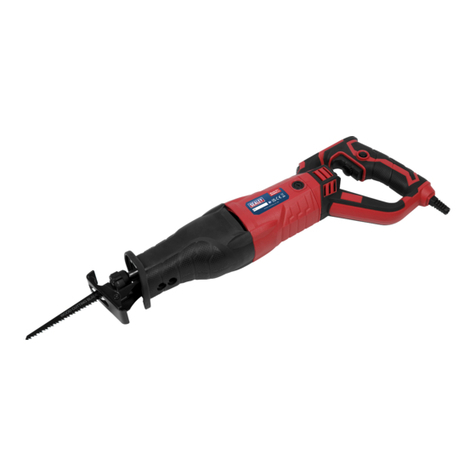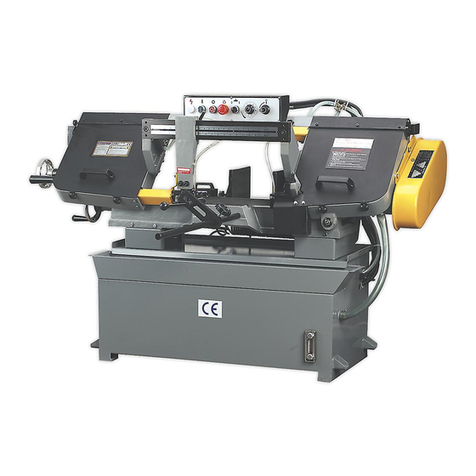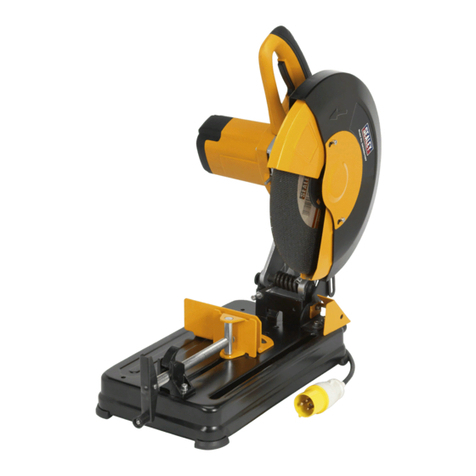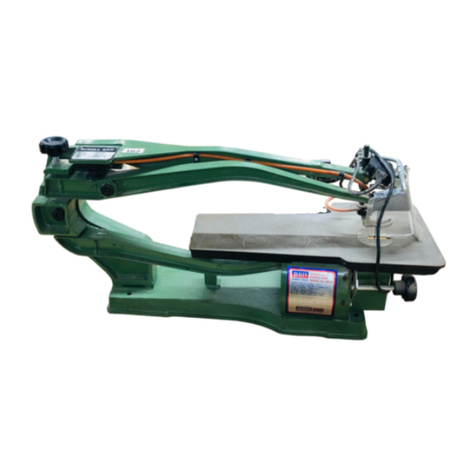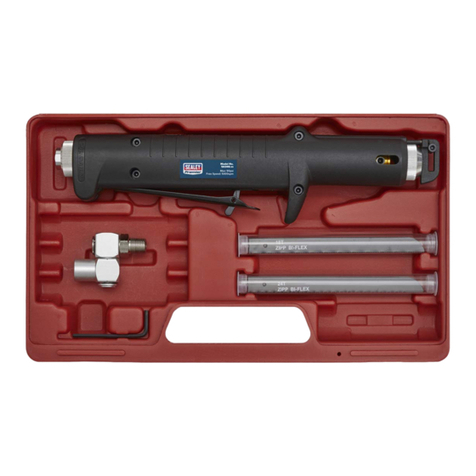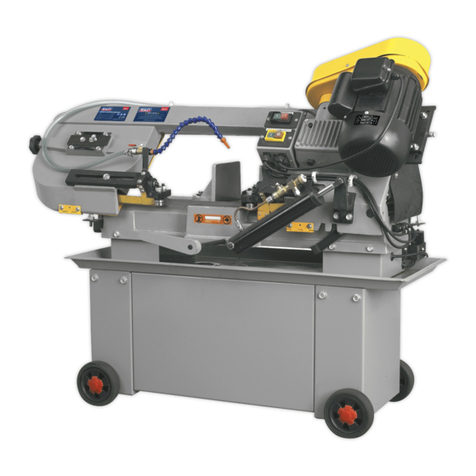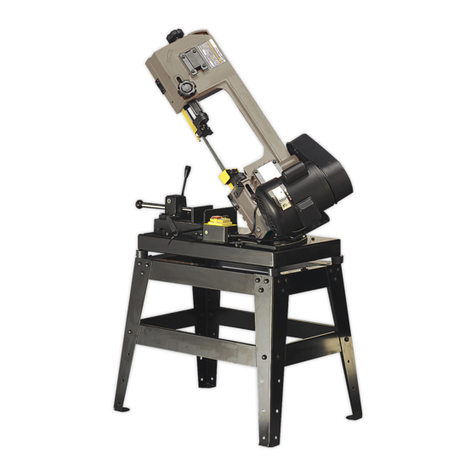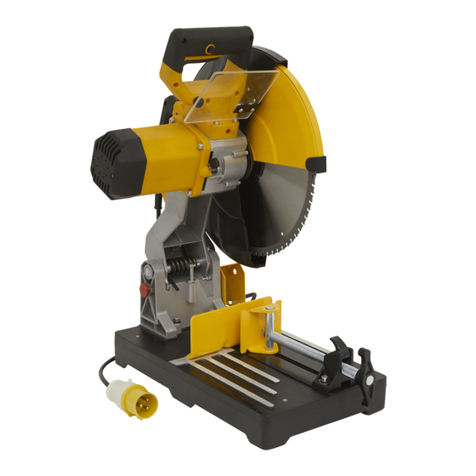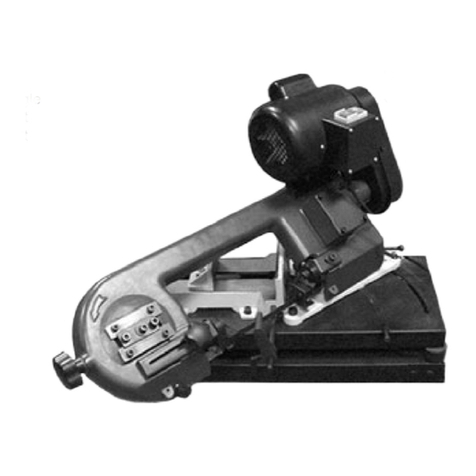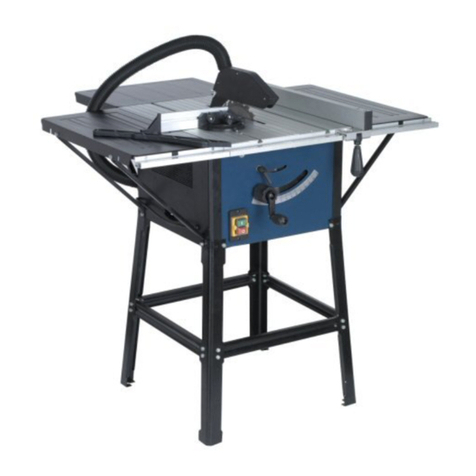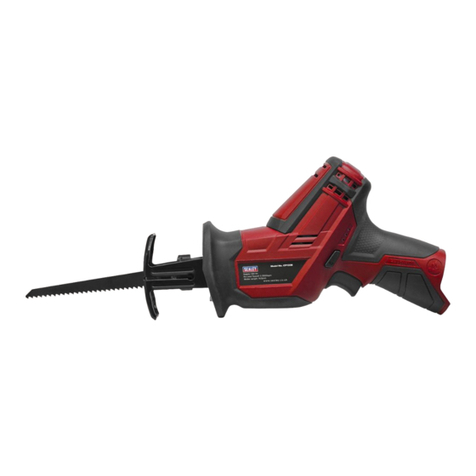
INSTRUCTIONS FOR:
10 COMPOUND MITRE SAW
Model No: SM10
Thank you for purchasing a Sealey product. Manufactured to a high standard this product will, if used according to these instructions
and properly maintained, give you years of trouble free performance.
1. SAFETY INSTRUCTIONS
IMPORTANT: PLEASE READ THESE INSTRUCTIONS CAREFULLY. NOTE THE SAFE OPERATIONAL REQUIREMENTS, WARNINGS AND
CAUTIONS. USE THIS PRODUCT CORRECTLY AND WITH CARE FOR THE PURPOSE FOR WHICH IT IS INTENDED. FAILURE TO DO SO MAY
CAUSE DAMAGE AND/OR PERSONAL INJURY AND WILL INVALIDATE THE WARRANTY. PLEASE KEEP INSTRUCTIONS SAFE FOR FUTURE USE.
SM10 - 0016 - (1) - 190601
1.1. ELECTRICAL SAFETY
p WARNING! It is the users responsibility to read, understand and comply with the following:
You must check all electrical equipment and appliances, before using, to ensure that they are safe. You must inspect power supply leads, plugs
and all electrical connections for wear and damage. You must ensure the risk of electric shock is minimised by the installation of appropriate
safety devices. An RCCB (Residual Current Circuit Breaker) should be incorporated in the main distribution board. We also recommend that an
RCD (Residual Current Device) is used with all electrical products. It is particularly important to use an RCD with portable products that are
plugged into an electrical supply not protected by an RCCB. If in doubt consult a qualified electrician. You may obtain a Residual Current Device
by contacting your Sealey dealer. You must also read and understand the following instructions concerning electrical safety.
1.1.1. The Electricity At Work Act 1989 requires all portable electrical appliances, if used on business premises, to be tested by
a qualified electrician, using a Portable Appliance Tester (PAT), at least once a year.
1.1.2. The Health & Safety at Work Act 1974 makes owners of electrical appliances responsible for the safe condition of the appliance
and the safety of the appliance operator. If in any doubt about electrical safety, contact a qualified electrician.
1.1.3. Ensure the insulation on all cables and the product itself is safe before connecting to the mains power
supply. See 1.1.1. & 1.1.2. above and use a Portable Appliance Tester (PAT).
1.1.4. Ensure that cables are always protected against short circuit and overload.
1.1.5. Regularly inspect power supply leads, plugs for wear and damage and power connections, to
ensure that none is loose.
1.1.6. Important: Ensure the voltage marked on the product is the same as the electrical power supply
to be used, and check that plugs are fitted with the correct capacity fuse. A 13 amp plug may require
a fuse smaller than 13 amps for certain products, see fuse rating at right.
1.1.7. DO NOT pull or carry the appliance by the power supply lead.
1.1.8. DO NOT pull the plug from the socket by the power cable.
1.1.9. DO NOT use worn or damage leads, plugs or connections. Immediately replace or have repaired by
a qualified electrician. A U.K. 3 pin plug with ASTA/BS approval is fitted. In case of damage, cut it off
and fit a new plug according to the following instructions (discard old plug safely).
(UK only - see diagram at right). Ensure the unit is correctly wired via a three-pin plug.
a) Note that this saw is double insulated and therefore there is no GREEN/YELLOW earth wire.
b) Connect the BROWN live wire to live terminal L.
c) Connect the BLUE neutral wire to the neutral terminal N.
d) After wiring, check that there are no bare wires, that all wires have been correctly connected, that the cable outer insulation
extends beyond the cable restraint and that the restraint is tight.
Double insulated products are fitted with live (BROWN) and neutral (BLUE) wires only. Double insulated products are always marked with
this symbol . To re-wire, connect the brown & blue wires as indicated above. DO NOT connect the brown or blue to the earth terminal.
1.1.10. Some products require more than a 13 amp electrical supply. In such a case, NO plug will be fitted. You must contact a qualified electrician
to ensure a 30 amp fused supply is available. We recommend you discuss the installation of a industrial round pin plug and socket with your electrician.
1.1.11. Cable extension reels. When a cable extension reel is used it should be fully unwound before connection. A cable reel with an RCD
fitted is recommended since any product which is plugged into the cable reel will be protected. The section of the cores of the cable
is important and should be at least 1.5mm2, but to be absolutely sure that the capacity of the cable reel is suitable for this product and
for others that may be used in the other output sockets, we recommend the use of 2.5mm2section cable.
Blue
Neutral
Wire
Cable
Restraint
FUSE RATING
THIS PRODUCT MUST BE FITTED
WITH A
13 AMP FUSE
Brown
Live
Wire
1.2 GENERAL SAFETY
3Familiarise yourself with the applications, limitations and potential hazards of the saw.
pWARNING! Disconnect the saw from the mains power before changing accessories, servicing or performing any maintenance.
3The machine must only be serviced by a qualified person or service agent. Contact your Sealey dealer for information.
3Select a work area suitable for the saw and keep the area clean, tidy and free from unrelated materials. Ensure that there is adequate lighting.
3Permanently mount the saw on a supporting surface strong enough to take the weight of the machine and workpiece.
3Wood dust can be harmful to health by inhalation and skin contact. Concentrations of small dust particles in the air can form an
explosive mixture. Ensure that there is adequate ventilation and that the saw is attached to a dust-extraction unit.
3Maintain the saw in good condition, check moving parts alignment regularly. Keep saw blades clean and sharp. ,
3Replace or repair damaged parts. Use recommended parts only. Unauthorised parts may be dangerous and will invalidate the warranty.
pWARNING! Keep all guards and holding screws in place, tight and in good working order. Check regularly for damaged parts.
A guard, or any other part, that is damaged should be repaired or replaced before the saw is next used. The safety guard is a mandatory
fitting where the saw is used in premises covered by the Health & Safety at Work Act.
3Before commencing work, ensure the saw blade is set to cut in the correct direction, securely fastened, sharp and is compatible with the
machine, spindle speed and the material to be cut. Never use a saw blade if damaged, bent or warped. Use only recommended saw blades.
3Remove adjusting keys and wrenches from the machine and the vicinity before switching on.
3Machine operators must have received sufficient training and instructions relating to the dangers associated with the machine, the
precautions to be observed and the requirements of the Wood Working Machines Regulations. Operators must be under the adequate
supervision of a person who has a thorough knowledge and experience of the machine and the appropriate regulations.
